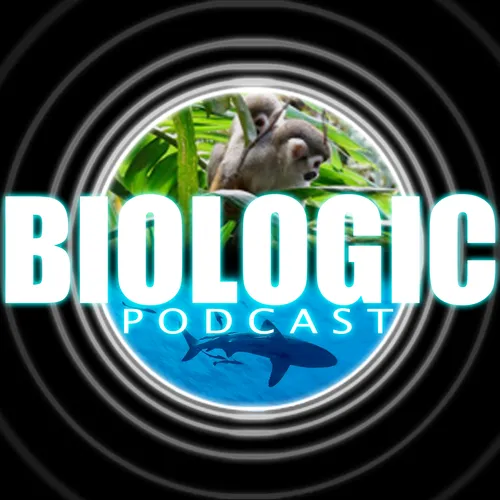
The Biologic Podcast
Welcome to the Biologic Podcast, an audio exploration of the incredible world of living things.
The journey begins at the dawn of life, almost 4 billion years ago. In this ancient eon, biochemical reactions gave rise to ordered systems (the cell) capable of replication. The key to this replication is the genome, and the DNA itself.
At this point, the journey expands in scope; we will explore the process of evolution, then move through hundreds of millions of years of evolutionary history until we come to the modern day, to survey the modern world's biodiversity. Then we'll take a step back to look at the ecological interactions of all this life, and the resulting biomes that define the surface of our planet Earth.
Our journey through the biological realm takes a sudden turn; having learned about life at the grandest scale, we now return to the ground, to look in greater detail at the various organisms that share this world with us. We first explore the physiology & diversity of plants, and then same for the fungi. Moving from flora to fauna, we explore the physiology & diversity of animals, up to and including the human being.
The path is long and the lessons hard, but for the ever-curious listener, there are many great discoveries and insights to be had in the world of the biological.
- Update frequency
- every 17 days
- Average duration
- 43 minutes
- Episodes
- 123
- Years Active
- 2019 - 2025

Episode 83 - Animal Hormones
The animal endocrine system is a complex decentralized chemical communication network that coordinates growth and homeostasis across the whole organism. Hormones are a critical component of this syst…

Episode 82 - Animal Nerves
Today we'll examine the chemistry, anatomy, and physiology of the animal nervous system, from action potentials to neural circuits to animal behavior.

Episode 81 - Animal Immunity
In this episode, we'll explore the complex dynamics of the defensive system that protects animals from the countless microbes and pathogens they encounter every day: the immune system!

Episode 80 - Animal Respiration
In this episode, we'll explore both the chemistry and physiology of animal respiration. This will also involve a brief exploration of the cardiovascular system, which is integral to the function of t…

Episode 79 - Animal Form & Function
The subtle but foundational relationship between form and function can be seen at all levels of biological organization, from cells to tissues to organs to limbs and body plans.

Episode 78 - Animal Movement
The ability to move, freely & autonomously, is one of the defining characteristics of all but the most basal animals, distinguishing them from the stationary plants, and the creeping fungi.

Episode 77 - Animal Reproduction
Animals are some of the most complex and dynamic organisms on Earth, and their mechanisms for reproduction are just as varied and complex.

Episode 76 - Animal Sensoria
An animal uses its senses to perceive and engage with the world around it, which is critical when you can move around an environment, searching for prey, and escaping predators.

Episode 75 - Animal Nutrition
All animals must eat food to survive, but how an animal eats, how often, and what it eats, play a fundamental role in the animal's evolution.

Episode 74 - Animal Hydration
Water is critical for life. So how does the animal body use its water? How does it maintain a healthy osmotic balance, to sustain life?

Episode 73 - Animal Development
Compared to plants and fungi, the animals have the most complex bodies, with the most complex body systems. Today, we'll explore the process of development that creates this complex animal body.

Episode 72 - Humans & Fungi
Today we'll be exploring the diverse and exciting ways in which Humans have used the many fungal species that share our planet.

Episode 71 - Basidiomycota
The basidiomycota are one of the most advanced and diverse groups of fungi, including all the puffballs, conks, and traditional mushrooms.

Episode 70 - Ascomycota
The ascomycota are one of two major divisions with the 'higher fungi'. Along with the basidiomycota, they have come to dominate the fungal kingdom, and have spread across all Earthly habitats.

Episode 69 - Glomeromycota
Hidden in the soil, the glomeromycota fungi seek out and fuse with the roots of plants, to engage in a symbiosis that sustains the worlds forests.

Episode 68 - Early Protozoa & Monokarya
The mysterious origin of the fungal lineage generated a diversity of fungal protozoa, which would give rise to the earliest true fungi.

Episode 67 - Fungal Evolution
The story of fungal evolution is shrouded in mystery, but what little evidence there is, suggests an incredibly long history that fundamentally influences all life on Earth.

Episode 66 - Fungal Ecology
The fungal organism engages with its community and environment in countless ways; without the fungi, much of life on Earth would not be possible.

Episode 65 - Fungal Reproduction
Among all the branches on the tree of life, the fungi have perhaps the most complex, diverse, and exotic means of reproducing, both sexually and asexually.

Episode 64 - Fungal Sensoria
Fungi sense the world with a variety of cellular and chemical structures, giving them a unique perspective of reality.